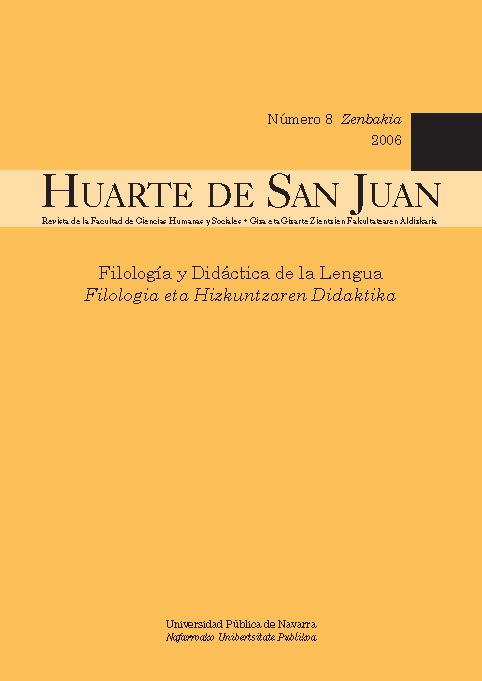Un curso de inglés para ingenierías técnicas agrícolas usando el aulario virtual
Abstract
Un curso de inglés para ingenierías técnicas agrícolas usando el aulario virtual
Downloads
References
Aguilera Jiménez, A. y García Gómez, I. (2000): “Una universidad para el siglo XXI: algunas pistas para la reflexion”, en Ortega Romero, A.; Castañeda Barrena, E. (eds.), Materiales para la calidad. Actas de las II Jornadas andaluzas de calidad en la enseñanza universitaria. Desarrollo de planes de calidad para la universidad, Instituto de Ciencias de la Educación, Universidad de Sevilla, Sevilla.
Alcaraz Varó, E. (2000): El inglés profesional y académico, Alianza, Madrid.
Bocanegra Valle, A. (2003): “Why teaching instrumental English at undergraduate level?”, en Luque Agulló, G.; Bueno González, A.; Tejada Molina, G. (eds.), Las lenguas en un mundo global, Universidad de Jaén, Jaén.
Brinton, D.M. & Holten, C.A. (2001): “Does the emperor have no clothes? A re-examination of grammar in content-based instruction”, en J. Flowerdew & M. Peacock (eds.), Research Perspectives on English for Academic Purposes, Cambridge University Press, Cambridge, pp. 239-252.
Bueno, M.C. (2004): “Needs Analysis: results, practical applications and students’ perceptions”, en Sanz Sainz, I.; Felices Lago, A. (eds.), Current trends of languages for Specific Purposes in an International and Multicultural Context, Universidad de Granada, Granada
Canton, M.L. y Gil, A.F. (2005): “Aula virtual y aprendizaje autodirigido en lenguas para fines específicos”, en Hernández, E.; Sierra, L. (eds.), Lenguas para Fines Específicos (VIII). Investigación y Enseñanza, Universidad de Alcalá, Alcalá de Henares.
Coxhead, A. (2000): “A New Academic Word List”, TESOL Quarterly, 34(2); 213-238.
Dovey, T. (2005): “What purposes, specifically? Re-thinking purposes and specificity in the context of the new ‘vocationalism’”, English for Specific Purposes (disponible en http://www.sciencedirect.com/science/journal/08894906 en Articles in press).
Duart, J.M. y Sangrà, A., “Formación universitaria por medio de la web: un modelo integrador para el aprendizaje superior”, www.uoc.edu/web/cat/articles/duart/Duart_Sangra.pdf [Consulta 10 de enero de 2006]
Fortanet, I.; Palmer, J.C. y Ruiz, M.F. (2005): “De general a específico: Carencias comunicativas orales detectadas por el profesorado de lengua inglesa”, en Hernandez, E.; Sierra, L. (eds.), Lenguas para Fines Específicos (VIII). Investigación y Enseñanza, Universidad de Alcalá, Alcalá de Henares.
Gatehouse, K. (2001): “Key Issues in English for Specific Purposes (ESP) Curriculum Development”, The Internet TESL Journal, 7.10. http://iteslj.org/
Gee, J.P.; Hully, G. y Lankshear, C. (1996): The new work order behind the language of the new capitalism, Allen & Unwin, Sydney.
Hammada T. & Scott, K. (2000): “A collaborative learning model”, The Journal of Electronic Publishing, 6 (1). http://www.press.umich.edu/jep/06-01/hamada.html
Hunston, S. (2002): Corpora in Applied Linguistics, Cambridge UP, Cambridge.
Kerres, M. (2002): “Online- und Präsenzelements in Leararrangements kombinieren”, en Hohenstein, A.; Wilbers, K. (eds), Handbuch E-Learning: Expertenwissen aus Wissenchaft und Praxis, Deutscher Wirtschagtsdienst, Köln.
Kowal, M. & Swain, M. (1994): “Using collaborative language production tasks to promote students’ language awareness”, Language Awareness, 3/2: 73-93.
Kupetz, R. & Ziegenmeyer, B. (2005): “Blended learning in a teacher training course: Integrated interactive e-learning and contact learning”, ReCALL, 17 (2): 179-196.
Leloup, J.W. & Ponterio, R. (2001): “On the Net. Sites for Soar(ing) Eyes”, Language Learning and Technology, 5/1 [Web document available at http://llt.msu.edu/vol5num1/onthenet/default.html]
Martínez, A.; Bellés, B. y Ruiz, N. (2004): “Using an Internet Resource Guide in the ESP classroom: A comparison of pair and individual work with students of computer Science”, en Sanz Sainz, I.; Felices Lago, A. (eds.), Current trends of languages for Specific Purposes in an International and Multicultural Context, Universidad de Granada, Granada.
Ministerio de Educación, Cultura y Deporte (2003): La Integración del Sistema Universitario Español en el Espacio Superior Europeo de Educación Superior, Documento-Marco.
Pierce McMahon, J. (2004): “Why integrate ICT into the ESP currículum at the tertiary level in Spain?”, en Sanz Sainz, I.; Felices Lago, A. (eds.), Current trends of languages for Specific Purposes in an International and Multicultural Context, Universidad de Granada, Granada.
Roldán Riejos, A.M. (2005): “Learning summary writing through multimedia”, en Hernandez, E.; Sierra, L. (eds.), Lenguas para Fines Específicos (VIII). Investigación y Enseñanza, Universidad de Alcalá, Alcalá de Henares.
Salazar, P. (2003): “The effects of comprehensible input on the process of language learning: A case study”, Rassegna Italiana di Linguistica Aplicata, 3.
Storch, N. (1998): “A classroom-based study: insights from a collaborative text reconstruction task”, ELT Journal, 52: 291-299.
Storch, N.(1999), “Are two heads better than one? Pair work and grammatical accuracy”, System, 27: 363-374.
Storch, N.(2002), “Patterns of interaction in ESL pair work”, Language Learning, 52: 119-158.
Ushi, F. (2000): “Learning on the Web – who does it, why and how? Paper presented as poster as part of the History of CALL exhibition at CALICO and EUROCALL 2000”, http://www.history-of-call.org.
Downloads
Published
How to Cite
Issue
Section
License
All articles are published under a Creative Commons (BY-NC-ND 4.0) license. Each article will be assigned a DOI.
Authors retain copyright of their work and grant the journal the right to the first publication. Authors can sign additional agreements to non-exclusive distribution of the published version of the article (for example, in an institutional repository) as long as appropriate attribution to the original publication is provided. Articles can be uploaded to institutional repositories immediately after publication.
Electronic distribution of the articles (for example, academic social networks or personal webpages) is allowed and encouraged.
The journal reserves the right to publicise the work in social networks and other electronic means.







